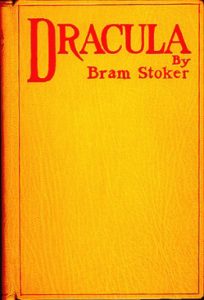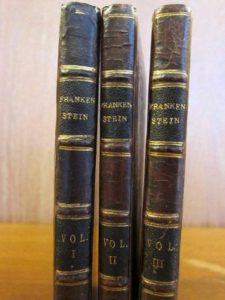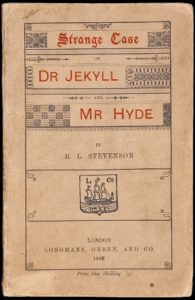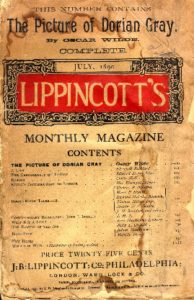Scarily Influenced… or Just Plain Mundane?
Marie Anne Cope takes a look at the origins of four classic horror tales
In deciding what to write for this Hallowe’en edition of Bookylicious, dear reader, my gaze alighted on my numerous bookshelves and began to roam the volumes, soon settling on my collection of classics. Four titles jumped up and down to get my attention and I found myself nodding in agreement and pondering their origins. Where did the authors get their ideas from? Were they influenced by anyone or anything? Was it a sinister beginning or just an ordinary idea which became extraordinary in its creation? Let’s find out, shall we?
We will start with my favourite, Dracula, written by Abraham ‘Bram’ Stoker and first published in England in 1897 by Archibald Constable & Company. The novel cost six shillings and was bound in yellow cloth with the title in distinctive red letters.
 Despite wide popular belief, Stoker did not base his immortal character on Vlad III Dracula, or Vlad the Impaler as he’s more affectionately known, although he did ‘borrow’ bits of insignificant information. There are no references to Vlad in Stoker’s notes for the book, yet the name of his creation, and many more after him, can only have come from one place.
Despite wide popular belief, Stoker did not base his immortal character on Vlad III Dracula, or Vlad the Impaler as he’s more affectionately known, although he did ‘borrow’ bits of insignificant information. There are no references to Vlad in Stoker’s notes for the book, yet the name of his creation, and many more after him, can only have come from one place.
Apparently, Stoker became intrigued by the name ‘Dracula’ whilst he was doing some research in Whitby Library, of all places. He came across a book called An Account of the Principalities of Wallachia and Moldavia with Political Observations Relative to Them by William Wilkinson, and discovered that ‘Dracula’ was the patronym of the descendants of Vlad II of Wallachia, who took the name ‘Dracul’.
In old Romanian, ‘Dracul’ means dragon and ‘Dracula’ means son of the dragon. In the present day, ‘Dracul’ means the devil…
Knowing this, I became more intrigued about where he got his inspiration from; it turns out, from many places. As Stoker spent seven years researching European folklore and stories of vampires, he must have had some interest in this area. The piece that caught his attention, and is said to have influenced him the most, is an essay by Emily Gerard in 1885, called Transylvania Superstitions. It would certainly make sense for this to have influenced him, given his setting for Dracula’s castle.
According to his wife, Stoker awoke from a nightmare, apparently the result of too much crabmeat, in which he dreamt of a vampire king rising from his grave. The timing of this dream could shed light on whether his research influenced his dream or vice versa.
The main influence on the character of Dracula, however, came from Stoker’s time as Business Manager for the Lyceum Theatre in London. The theatre was headed by actor-manager Henry Irving, and it is from Irving that Dracula attained his dramatic sweeping gestures and gentlemanly mannerisms. Stoker had hoped Irving would play Dracula in a stage version of the novel, but Irving would never agree to put it on the stage.
It seems clear that, for Stoker, there was no one influence for his iconic novel. Instead he found several scarily influential ideas, which all merged together to bring us a truly immortal character.
Dracula was Stoker’s only notable work.
 Next is a story which I’ve never read, but which I have seen adapted multiple times on the big screen. Frankenstein; or, The Modern Prometheus was written by Mary Wollstonecraft Shelley and published anonymously in 1818 by Lockington, Hughes, Harding, Mavor & Jones. The preface was written for Mary by her husband, Percy Bysshe Shelley, and the novel was published in three volumes, the traditional ‘triple decker’ format for 19th century first editions.
Next is a story which I’ve never read, but which I have seen adapted multiple times on the big screen. Frankenstein; or, The Modern Prometheus was written by Mary Wollstonecraft Shelley and published anonymously in 1818 by Lockington, Hughes, Harding, Mavor & Jones. The preface was written for Mary by her husband, Percy Bysshe Shelley, and the novel was published in three volumes, the traditional ‘triple decker’ format for 19th century first editions.
We all know the story of ‘The Year Without Summer’ in 1816, when it rained constantly following a long, cold, volcanic winter due to the eruption of Mount Tambora in 1815. It was this summer that the Shelleys joined John Polidori and Lord Byron at Lake Geneva. One night, they decided to have a competition to see who could write the scariest horror story, and it was at the lake that Shelley had a dream about a scientist who created life and was horrified by what he had made… and so Frankenstein was born.
You may think this was a random dream, but was it really? Prior to this, in 1814, Shelley had travelled through Europe, along the Rhine in Germany, and stopped in Gernsheim. Gernsheim is about 10 miles from Frankenstein Castle where, two centuries earlier, an alchemist had been engaged in experiments. Later, she travelled in the region of Geneva in Switzerland, which is where much of the story is based, and where she and her friends discussed the topics of galvanism (the contraction of a muscle stimulated by an electric current) and other occult ideas. Did these prior trips come racing to the forefront of her mind once the seed had been sown?
Over the years, there have been many citations for what influenced Shelley in her story, the main ones being Ovid’s version of the Promethean myth, Paradise Lost by John Milton and The Rime of the Ancient Mariner by Samuel Taylor Coleridge. The ideas for Frankenstein’s character himself are said to have come from Humphrey Davy’s book Elements of Chemical Philosophy.
Although never referred to by Shelley in her notes, several of her contemporaries have been cited as having an influence on her creation. Giovanni Aldini made public attempts at human re-animation through bio-electric galvanism in London, and Johann Konrad Dippel was supposed to have developed the chemical means to extend the lifespan of humans.
Whilst these influences certainly fitted in with the finished article, couldn’t Shelley, like me, just have had a very dark and twisted imagination? I am not saying the topics of the day didn’t play a part, but maybe a smaller one than people want to admit. After all, if she had reviewed the works of these chaps, I’m sure she would have mentioned them somewhere in her notes.
Again, for me, the little nuggets Shelley picked up over the years gave a dark and warped influence to her story.
Although she wrote many novels, Frankenstein is the one she is most known for.
 Strange Case of Dr Jekyll and Mr Hyde is a novella by Robert Louis Balfour Stevenson and was first published in 1886. The US publisher Scribner’s issued the novella on 5 January 1886, four days before the UK edition, which was published by Longman Green & Company. The work sold 40,000 copies in the first six months!
Strange Case of Dr Jekyll and Mr Hyde is a novella by Robert Louis Balfour Stevenson and was first published in 1886. The US publisher Scribner’s issued the novella on 5 January 1886, four days before the UK edition, which was published by Longman Green & Company. The work sold 40,000 copies in the first six months!
Stevenson had long been interested in how personalities can affect human behaviour and how to incorporate the mix of good and evil into a story. In his essay A Chapter on Dreams in 1888, he confessed that he had been racking his brain to think of a story and had then had a dream (seems to be a bit of a theme here), which resulted in two to three scenes for Jekyll and Hyde. Apparently, his wife had woken him up just as he’d got to the first transformation scene. He was not best pleased!
A big influence on the story was his friendship with Edinburgh-based French teacher, Eugene Chantrelle. Chantrelle was an ordinary man with a seemingly normal life who, in May 1878, was convicted and executed for the murder of his wife; he had poisoned her with opium. This conflicting image of a mild-mannered man who could commit such a crime had a marked effect on Stevenson, and it would make sense for it to have influenced his creation of a monster from a well-respected doctor.
Many biographers alleged that Stevenson was on drugs when he wrote Jekyll and Hyde; the drugs ranged from cocaine to ergot. His wife and son, however, said he was bedridden and sick at the time, and the fact that he moved to Bournemouth, where he could benefit from the sea air and warmer climate for his ill health, would support this.
The influence here seems to have moved away from the dark and scary into the darkly scientific, an area a bit more grounded in reality.
Although Stevenson penned many notable works during his lifetime, Strange Case of Dr Jekyll and Mr Hyde is one of his best-selling tales.
 Finally, we come to a story that is both charming and disturbing. The Picture of Dorian Gray by Oscar Fingal O’Flahertie Wills Wilde was first published as a complete story in the July 1890 issue of Lippincott’s Monthly Magazine.
Finally, we come to a story that is both charming and disturbing. The Picture of Dorian Gray by Oscar Fingal O’Flahertie Wills Wilde was first published as a complete story in the July 1890 issue of Lippincott’s Monthly Magazine.
The story was heavily cut, unbeknownst to Wilde, by the magazine’s editor and yet, despite this cull, Dorian Gray still offended the ‘moral sensibilities’ of British book reviewers. Some of these reviewers actually thought Wilde should be prosecuted for violating the laws of public morality.
As a result of this, when the book edition was published in 1891 by Ward, Lock & Company, the preface became famous in its own right, as Wilde had written a defence of the artist’s rights and of art for art’s sake.
The Picture of Dorian Gray, the only novel ever written by Wilde, contains strong themes that can only have been influenced by Faust: a temptation is placed before the protagonist, in which he indulges, before he is destroyed.
It is said that a possible influence on the story came from British Prime Minister Benjamin Disraeli’s works, especially his first novel, Vivian Grey. Is it too much of a stretch to believe that Dorian’s love interest, Sibyl Vane, draws her name from Disraeli’s novel Sybil, or that Vivian Grey’s love interest, Violet Fane, resembles Sibyl Vane in the tragic manner of her death?
There is also a scene in Vivian Grey in which the eyes in the portrait of a ‘beautiful being’ move when its subject dies. Coincidence? Seems to be bordering on plagiarism, don’t you think?
With regard to influence, we see another shift as Wilde mixes the darkly sinister with the psychological to bring us a story of indulgence and, in some ways, control over others. Could this be a precursor to zombie tales, as Frankenstein has been cited as being? After all, the zombie tradition is heavily influenced by slavery and voodoo: another person having control of one’s mind and willpower. Food for thought, don’t you think, dear reader?
Although Wilde is a well-known playwright, The Picture of Dorian Gray stands alongside The Importance of Being Earnest: the two are his most notable works.
Scary or mundane? Fascinating or predictable? The influences for writers can be varied and yet the same. Dreams have played a huge part in the timeless creations I have talked about here, so is it time for us all to chase the dragon or the green fairy and succumb to the deepest darkest depths of our dreams… if we dare?
May fear protect you when the darkness comes.
© Marie Anne Cope 2017
